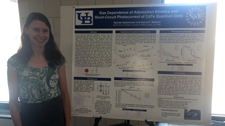News
October 12, 2015Investigating Quantum Dots
By Rachel Hutchinson, Mathematics/Chemistry, ‘16
This past summer, I participated in an REU program at the University at Buffalo. In that program, I did research with Dr. David Watson, investigating quantum dots, which are semiconducting nanocrystals. Quantum dots are unique because when their size changes, their bandgap changes. The bandgap is the energy difference between the conduction band and the valence band. This change in bandgap causes the color of the quantum dots to change when their size changes. During the program, I synthesized four different sized CdTe quantum dots in aqueous solution. They had diameters of approximately 1.6 nm, 2.2 nm, 3.2 nm, and 3.5 nm. I then did experiments to investigate the adsorption of the quantum dots onto TiO2 films on glass slides, and determine if the size of the quantum dots affected their adsorption. I put the slides into the quantum dot solutions and then measured the absorbance of the slides with a UV-vis to determine the surface coverage of the slides. I used different concentrations of quantum dots to determine how the adsorption was affected by the concentration. I also measured the adsorption over time. The concentration dependence appeared to follow the Langmuir isotherm model and the adsorption kinetics appeared to follow the Langmuir kinetic model, so I used these models to calculate equilibrium and rate constants for the adsorption. Based on the experiments, the maximum surface coverage decreased as the size of the quantum dots increased, the equilibrium constant increased as the size increased, and the rate constant increased as size increased.
Additionally, I put the quantum dots onto TiO2 flourine-doped tin oxide films and used that as the working electrode in a photoelectrochemical cell to measure how well it could convert light into electricity. The purpose of this experiment was to determine how efficient a solar cell made with these quantum dots would be, as well as if the size of the quantum dots affected the efficiency. Based on this experiment, the size of the quantum dots did not affect the efficiency. However, all four sizes had low incident photon-to-current efficiencies, suggesting they would not make an efficient solar cell.
I enjoyed the research experience, and I am glad I was able to take advantage of this opportunity. It gave me a better understanding of what graduate school is like, what chemistry research involves, and how to approach scientific research. Furthermore, it gave me a greater appreciation for chemistry research and its value both for developing technology and gaining understanding about the world we live in.

